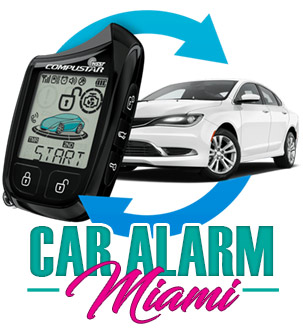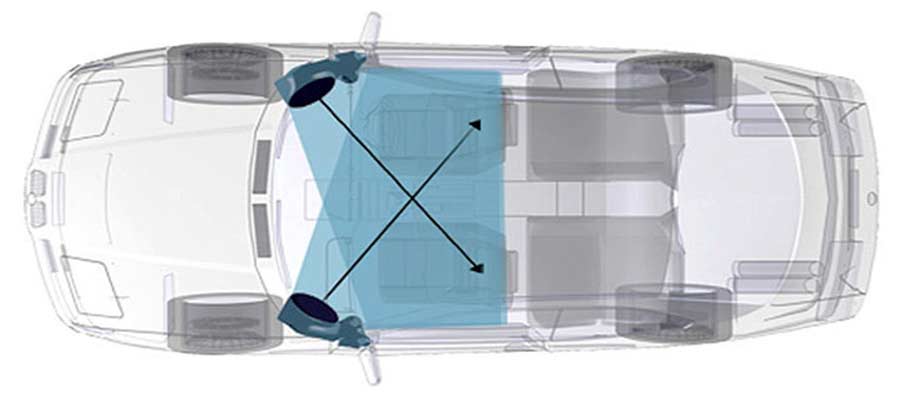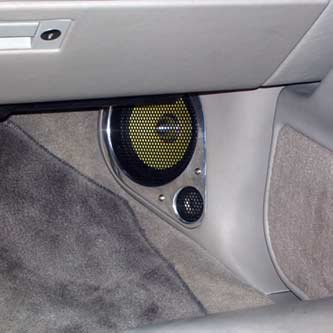If you are really into car stereos, not just into trunk-rattling bass, you have probably heard the term “front stage.” Primarily known in the IASCA competition circuit, the front stage is one of the most elusive and difficult criteria for a car audio system. Front Stage is considered by many as the ultimate goal in a custom car stereo system because power can not correct it, brands, equalization, neon, Plexiglas, LED, motorization, wire gauge, etc. The sound front stage is a combination of equipment selection and installation. This ratio is 30% equipment selection and 70% installation and design.
So, what is a front stage?
Front Stage is a phenomenon that occurs when listening to a high-performance sound system at an equal distance from the speakers at the center position. In other words, the distance between you to the right speaker, you to the left speaker, and the left speaker to the right speaker is the same. Unlike BOSE’s definition of high fidelity – Good Front stage refers to an audiophile term used to describe when a sound system can replicate (resolve) the scenario (placement) of a singer and instrument within a sound stage or studio. This usually means the singer or vocalist is at the center, with the chorus behind, the drummer behind them, the bass to one side, and the lead guitar or keyboard to the other. A sound system with an excellent front stage can place this sound at a physical location many times, extending beyond the boundaries of a vehicle. Some world-renowned competition vehicles like Richard Clark’s famous Buick Grand National and others are known for placing the center stage 10 to 15 feet in front of the windshield when you close your eyes.
How do you achieve good “Front Stage” in a car
Based on this notion, car makers have been fooling around trying to achieve this phenomenon by means of employing digital sound processors (DSP) in the case of Lexus, Infinity, and others with the placement of speakers in a different location, primarily the center of the dash and pillars. DSP is not the way to go (this is a joke)! While minor time alignment is sometimes necessary due to the physical characteristics of the vehicle, anything over 100 milliseconds is highly undesirable. The best way to achieve a consistent front stage is by using speaker placement. The way to accomplish this is using a kick panel (a.k.a fiberglass speaker pods). In some cases, pillar mounted teeter and, in even fewer cases, the employment of a center channel speaker. The front stage refers to stereo playback, not DTS, 5.1, or 7.1 Dolby!
Summary of “Front Stage” in a car
The front stage requires a lot of planning and tuning, something only 1 in 100 custom car stereo systems can achieve. In many cases, it needs replacing equipment and mismatching brands and components. That can be drama because many car audio enthusiasts have a pretty strong mindset about the brands they like and the sound they produce. So, whether you are planning to participate in the IASCA competition circuit or simply trying to achieve what your B&M or Martin Logan home speakers can do, come and see us for a free evaluation of how we can improve the front stage of your car’s sound system.
What is a Car Audio Front Stage with Kick Panels?
A car audio front stage with kick panels is a strategic arrangement of speakers and components in a vehicle’s audio system. This setup, which focuses on the front soundstage and utilizes kick panels for speaker placement, can significantly enhance your listening experience, providing a more balanced and immersive soundstage and improved clarity, detail, and bass impact.
- Front Stage: The “front stage” in a car audio system refers to the speakers positioned at the front of the vehicle, typically consisting of two sets of speakers: the left and right front speakers (often referred to as the “front door speakers”) and the left and right tweeters (usually mounted higher up in the vehicle, such as on the dashboard or A-pillars). The front stage produces most of the music’s sound, creating a sense of depth, imaging, and realism.
- Kick Panels: Kick panels are at the bottom of the vehicle’s interior, typically near the driver and passenger’s feet. In a car audio system, kick panels can be utilized as mounting locations for additional speakers, usually midrange or midbass drivers. Positioning speakers in the kick panels closer to the listener’s ears and feet can enhance sound imaging, staging, and bass response.
In a car audio front stage with kick panels setup, the front door speakers and tweeters handle the high and midrange frequencies. In contrast, additional midrange or midbass drivers installed in the kick panels reinforce the lower frequencies. This arrangement helps create a more balanced and immersive soundstage with improved clarity, detail, and bass impact.
Using kick panels in-car audio systems allows for more strategic speaker placement, optimizing the listening experience and overcoming some of the limitations of factory-installed speaker locations. However, implementing kick panels typically requires custom fabrication work to ensure proper fitment and integration with the vehicle’s interior. Professional installation by experienced car audio technicians is often recommended to achieve the best results with a front-stage setup featuring kick panels.


